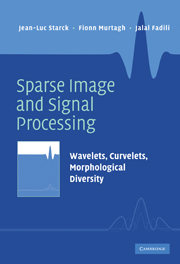Book contents
- Frontmatter
- Contents
- Acronyms
- Notation
- Preface
- 1 Introduction to the World of Sparsity
- 2 The Wavelet Transform
- 3 Redundant Wavelet Transform
- 4 Nonlinear Multiscale Transforms
- 5 The Ridgelet and Curvelet Transforms
- 6 Sparsity and Noise Removal
- 7 Linear Inverse Problems
- 8 Morphological Diversity
- 9 Sparse Blind Source Separation
- 10 Multiscale Geometric Analysis on the Sphere
- 11 Compressed Sensing
- References
- List of Algorithms
- Index
- Plate section
10 - Multiscale Geometric Analysis on the Sphere
Published online by Cambridge University Press: 06 July 2010
- Frontmatter
- Contents
- Acronyms
- Notation
- Preface
- 1 Introduction to the World of Sparsity
- 2 The Wavelet Transform
- 3 Redundant Wavelet Transform
- 4 Nonlinear Multiscale Transforms
- 5 The Ridgelet and Curvelet Transforms
- 6 Sparsity and Noise Removal
- 7 Linear Inverse Problems
- 8 Morphological Diversity
- 9 Sparse Blind Source Separation
- 10 Multiscale Geometric Analysis on the Sphere
- 11 Compressed Sensing
- References
- List of Algorithms
- Index
- Plate section
Summary
INTRODUCTION
Many wavelet transforms on the sphere have been proposed in past years. Using the lifting scheme, Schröder and Sweldens (1995) developed an orthogonal Haar wavelet transform on any surface, which can be directly applied on the sphere. Its interest is, however, relatively limited because of the poor properties of the Haar function and the problems inherent to orthogonal transforms.
More interestingly, many papers have presented new continuous wavelet transforms (Antoine 1999; Tenorio et al. 1999; Cayón et al. 2001; Holschneider 1996). These works have been extended to directional wavelet transforms (Antoine et al. 2002; McEwen et al. 2005). All these continuous wavelet decompositions are useful for data analysis but cannot be used for restoration purposes because of the lack of an inverse transform. Freeden and Windheuser (1997) and Freeden and Schneider (1998) proposed the first redundant wavelet transform, based on the spherical harmonics transform, which presents an inverse transform. Starck et al. (2006) proposed an invertible isotropic undecimated wavelet transform (IUWT) on the sphere, also based on spherical harmonics, which has the same property as the starlet transform; that is, the sum of the wavelet scales reproduces the original image. A similar wavelet construction (Marinucci et al. 2008; Faÿ and Guilloux 2008; Faÿ et al. 2008) used the so-called needlet filters. Wiaux et al. (2008) also proposed an algorithm that permits the reconstruction of an image from its steerable wavelet transform.
- Type
- Chapter
- Information
- Sparse Image and Signal ProcessingWavelets, Curvelets, Morphological Diversity, pp. 245 - 276Publisher: Cambridge University PressPrint publication year: 2010



